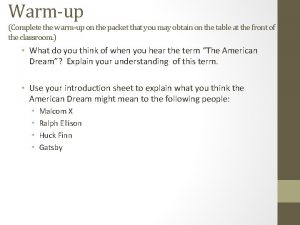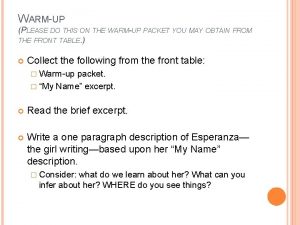Warmup Complete the warmup on the packet that







- Slides: 7

Warm-up (Complete the warm-up on the packet that you may obtain on the table at the front of the classroom. WRITE IN FULL SENTENCES. ) • What do you think of when you hear the term “The American Dream”? Explain your understanding of this term. • Explain what you think the American Dream might mean to the following people: 1. 2. 3. 4. 5. A single mom. A famous person. A person whose family has had no college education. A typical middle-class family. A person living in another country: How do they perceive the American Dream?

The American Dream The Myth and the Reality; rhetorical devices

• The term “American Dream” was first used by James Truslow Adams in his book, The Epic of America, written in 1931. Adams states that the American Dream is “that dream of a land in which life should be better and richer and fuller for everyone, with opportunity for each according to ability or achievement… It is not a dream of motor cars and high wages merely, but a dream of social order in which each man and each woman shall be able to attain to the fullest stature of which they are innately capable, and be recognized by others for what they are, regardless of the fortuitous circumstances of birth or position. ”

“I Have a Dream” Speech • • • Articulates his dream for America. Shows the way in which we haven’t “arrived. ” August 28, 1963 (51 years ago tomorrow!) Delivered to 250, 000 civil rights supporters. From the Lincoln Memorial in Washington DC. Excellent example of rhetoric.

Rhetorical Devices • Rhetoric: art of effective or persuasive speaking or writing. • Logical Appeal (logos) – appeal to rationality. • Emotional Appeal (pathos) – stir readers’ feelings; personalize the issue for the audience. • Ethical Appeal (ethos) – establish yourself as a credible speaker based on credentials and experience; show yourself as trustworthy.

Devices Continued • Analogies – give readers new ways of thinking about your issue by making a comparison between your issue and something familiar. • Repetition – focuses readers’ attention on key terms and core ideas. • Rhythm – create rhythm by using rhymes, repetition, pauses, and variations in line length, and by balancing long and short words or phrases. • Allusion – connection to something familiar

“I Have a Dream” Analysis • Mark up the text as we listen to/watch the speech. • Afterward, complete 4 Dialectical Journals in which you note examples of rhetoric throughout King’s speech. • Model: Example of Rhetoric 1. Explanation













